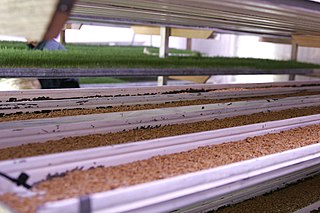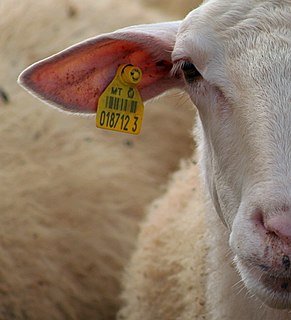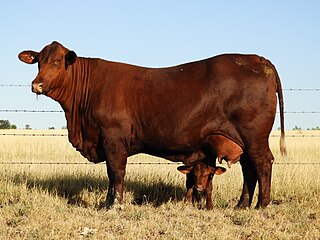Radio-frequency identification (RFID) uses electromagnetic fields to automatically identify and track tags attached to objects. An RFID system consists of a tiny radio transponder, a radio receiver and transmitter. When triggered by an electromagnetic interrogation pulse from a nearby RFID reader device, the tag transmits digital data, usually an identifying inventory number, back to the reader. This number can be used to track inventory goods.
Traceability is the capability to trace something. In some cases, it is interpreted as the ability to verify the history, location, or application of an item by means of documented recorded identification.

A feedlot or feed yard is a type of animal feeding operation (AFO) which is used in intensive animal farming, notably beef cattle, but also swine, horses, sheep, turkeys, chickens or ducks, prior to slaughter. Large beef feedlots are called concentrated animal feeding operations (CAFO) in the United States and intensive livestock operations (ILOs) or confined feeding operations (CFO) in Canada. They may contain thousands of animals in an array of pens.

Fodder, also called provender, is any agricultural foodstuff used specifically to feed domesticated livestock, such as cattle, rabbits, sheep, horses, chickens and pigs. "Fodder" refers particularly to food given to the animals, rather than that which they forage for themselves. Fodder includes hay, straw, silage, compressed and pelleted feeds, oils and mixed rations, and sprouted grains and legumes. Most animal feed is from plants, but some manufacturers add ingredients to processed feeds that are of animal origin.

Livestock branding is a technique for marking livestock so as to identify the owner. Originally, livestock branding only referred to hot branding large stock with a branding iron, though the term now includes alternative techniques. Other forms of livestock identification include freeze branding, inner lip or ear tattoos, earmarking, ear tagging, and radio-frequency identification (RFID), which is tagging with a microchip implant. The semi-permanent paint markings used to identify sheep are called a paint or color brand. In the American West, branding evolved into a complex marking system still in use today.

A microchip implant is an identifying integrated circuit placed under the skin of an animal. The chip, about the size of a large grain of rice, uses passive radio-frequency identification (RFID) technology, and is also known as a PIT tag. Standard pet microchips are typically 11–13 mm long and 2 mm in diameter.
Automatic identification and data capture (AIDC) refers to the methods of automatically identifying objects, collecting data about them, and entering them directly into computer systems, without human involvement. Technologies typically considered as part of AIDC include QR codes, bar codes, radio frequency identification (RFID), biometrics, magnetic stripes, optical character recognition (OCR), smart cards, and voice recognition. AIDC is also commonly referred to as "Automatic Identification", "Auto-ID" and "Automatic Data Capture".

Live export is the commercial transport of livestock across national borders. The trade involves a number of countries with the Australian live export industry being one of the largest exporters in the global trade. According to the Australian Bureau of Statistics, exports of live sheep rose 21.4% and live calves increased 9.7% between March 2017 and March 2018. During 2017 alone, Australia exported 2.85 million living animals in shipping containers and airplanes. The expansion of the trade has been supported by the introduction of purpose-built ships which carry large numbers of animals. The amount of livestock exported from the European Union grew to nearly 586m kilograms between 2014 and 2017, a 62.5% increase during the time period.
The Centro Nacional de Tecnologia Electrônica Avançada S.A is a Brazilian technology center specialized in project development and fabrication in microelectronics, i.e. integrated circuits, or "chips". This center is one of the agents for the Brazilian Microelectronics Program.

An ear tag is a plastic or metal object used for identification of domestic livestock and other animals. If the ear tag uses Radio Frequency Identification Device (RFID) technology it is referred to as an electronic ear tag. Electronic ear tags conform to international standards ISO 11784 and ISO 11785 working at 134.2 kHz, as well as ISO/IEC 18000-6C operating in the UHF spectrum. There are other non-standard systems such as Destron working at 125 kHz. Although there are many shapes of ear tags, the main types in current use are as follows:

The Santa Gertrudis is an American breed of beef cattle. It is a taurine-indicine hybrid breed, descended from both zebu and European cattle. It was bred in the early twentieth century in Texas, and received official recognition in 1940. It has been exported to many countries including Australia, Brazil and South Africa, and has contributed to the development of a number of modern breeds, among them the Barzona and the Droughtmaster.
The National Animal Identification System, (naisG) is a government-run program in the United States intended to extend government animal health surveillance by identifying and tracking specific animals. Administered at the federal level by the Animal and Plant Health Inspection Service, a branch of the United States Department of Agriculture, NAIS will also be overseen by state animal health boards. While the federal program is voluntary, money received by some states, tribes, and non-profit entities from the USDA through cooperative agreements has been used to make parts or all of the program mandatory.
Information and communication technology in agriculture, also known as e-agriculture, focuses on the enhancement of agricultural and rural development through improved information and communication processes. More specifically, e-agriculture involves the conceptualization, design, development, evaluation and application of innovative ways to use information and communication technologies (ICTs) in the rural domain, with a primary focus on agriculture. ICT includes devices, networks, mobiles, services and applications; these range from innovative Internet-era technologies and sensors to other pre-existing aids such as fixed telephones, televisions, radios and satellites. Provisions of standards, norms, methodologies, and tools as well as development of individual and institutional capacities, and policy support are all key components of e-agriculture.

An earmark is a cut or mark in the ear of livestock animals such as cattle, deer, pigs, goats, camels or sheep, made to show ownership, year of birth or sex.
The British Cattle Movement Service (BCMS) is the organisation responsible for maintaining a database of all bovine animals in Great Britain; Northern Ireland has a separate database maintained by the Department of Agriculture and Rural Development. It was established in the wake of the mad cow disease crisis in the UK, and is part of the Rural Payments Agency. Other member states of the European Union have similar cattle tracing systems.
National Animal Identification and Tracing (NAIT) is a system of agricultural animal tracing in New Zealand for biosecurity and human health. The schemes use radio-frequency identification (RFID) technology and a national database to trace animals from birth to either slaughter or live export.
A human microchip implant is any electronic device implanted subcutaneously (subdermally) usually via an injection. Examples include an identifying integrated circuit RFID device encased in silicate glass which is implanted in the body of a human being. This type of subdermal implant usually contains a unique ID number that can be linked to information contained in an external database, such as identity document, criminal record, medical history, medications, address book, and other usage.

Meat & Livestock Australia (M&LA) is an independent company which regulates standards for meat and livestock management in Australian and international markets. Headquartered in North Sydney, Australia; M&LA works closely with the Australian government, and the meat and livestock industries. As a multi-faceted authority, M&LA has numerous roles across the financial, public and research sectors. The M&LA corporate group conducts research and offers marketing services to meat producers, government bodies and market analysts alike. Forums and events are also run by M&LA aim to provide producers with the opportunity to engage with other participants in the supply chain.
Precision livestock farming (PLF) is a set of electronic tools for managing livestock. It involves automated monitoring of animals to improve their production/reproduction, health and welfare, and impact on the environment. PLF tracks large animals, such as cows, "per animal"; however, it tracks animals like poultry "per flock". The whole flock in a house is tracked as one animal, especially in broilers.

Animal identification using a means of marking is a process done to identify and track specific animals. It is done for a variety of reasons including verification of ownership, biosecurity control, and tracking for research or agricultural purposes.










